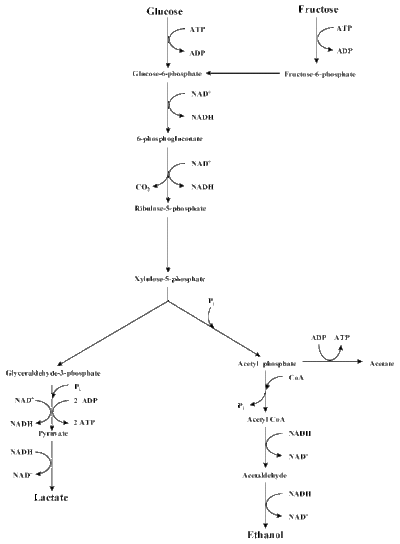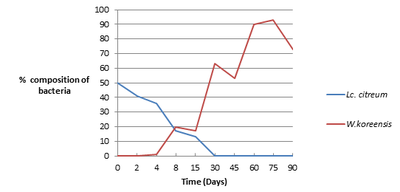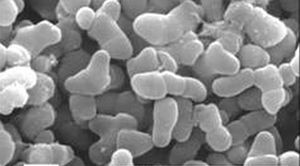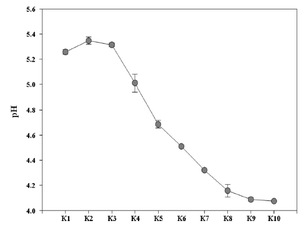Weissella koreensis
Classification
Kingdom: Bacteria
Division: Firmicutes
Class: Bacilli
Order: Lactobacillales
Family: Leuconostocaceae
Species: Weissella koreensis
Description
Weissella koreensis is the predominant lactic acid bacteria (LAB) isolated from kimchi, a traditional Korean fermented-vegetable food [7]. Collins et al. first proposed this species in 1993 based on 16S rRNA gene phylogenetic analysis [6]. Members of the genus Weissella are Gram-positive, facultative anaerobic, non-motile, heterofermentative, non-spore-forming and acid tolerant [3][6]. The cells are either irregular, short rods with rounded to tapered ends or coccoid [6]. As a psychrophilic bacterium, W. koreensis is the dominating species in fermenting kimchi at -1ºC, and it significantly contributes to kimchi’s taste and flavoring [3][7].
Significance
Studies have shown that the LAB isolated during kimchi fermentation exhibit antimicrobial activities by producing compounds such as organic acids, fatty acids and hydrogen peroxide [3]. W. koreensis also shows anti-obesity effects by producing the non-protein amino acid ornithine [7]. W. koreensis contributes to sourdough fermentation to improve the quality of bread by producing D (-)-lactic acid and metabolites from glucose [3] [6]. Acetic acid, being one of the products of fermentation, not only improves the flavor of the sourdough, but also increases the shelf life [3]. It has also been found that W. koreensis inhibits spore germination of the target microorganism during food fermentation [3].
Genome Structure
Strain KCTC 3621 of W.koreensis possesses one chromosome with 1672 coding sequences, 61 tRNA genes and 5 rRNA loci [5]. The chromosome has 1.7Mb and a low GC- content (Guanine-Cytosine content) ratio (35.5%), typical of a low GC Gram-positive phylum Firmicutes [5]. A relatively small percentage of the open reading frames (23.4% ) matches with the potential protein sequence in a public database while 7.7% of the genes are specific in KCTC 3621 but not in other Weissella species’ gene sequences [5]. The genome of strain KACC 15510 of W.koreensis is most closely related to strain KCTC 3621, sharing 98.76% and 99.48% similarity values which further confirms that both strains belong to the same species [5]. Upon studying the genome of strain KCTC 3621, six genes related to ornithine metabolism, five genes related to arginine metabolism and six genes related to antibiotic resistance are found [5].
Lactic Acid Bacteria (LAB) Metabolism

Heterofermentative LAB use carbohydrates as both a carbon and an energy source. [4][10]. The metabolism of heterofermentative pathway, as compared to homofermentative pathway, results in a diverse set of end products (ethanol, CO2) besides lactic acid [1][8] (Figure 1). As a heterofermentative LAB, W.koreensis uses phosphoketolase pathway when fermenting hexose to lactate, CO2 and ethanol/acetate [1][10]. Glucose is first dehydrogenated to form 6-phosphogluconate, followed by decarboxylation yielding CO2 [1]. Then phosphoketolase cleaves the resulting pentose-5-phosphate into glyceraldehyde phosphate (GAP) and acetyl phosphate [1]. GAP is further metabolized the same way as in the glycolytic pathway, producing lactic acid [1]. Alternatively, if no additional electron acceptor is available (O2), acetyl phosphate is reduced to form ethanol under anaerobic condition [1][8].
Physiological characteristics
Based on morphological, physiological and chemotaxonomic characteristics, strains S-5623 and S-5673 of W. koreensis sp. are considered to represent the novel species of genus Weissella [3][6]. Studies have shown that these two strains are catalase-negative facultative anaerobes [6]. The optimal growth temperature and pH are 25ºC and 6.0 respectively [6], with a sub-zero low-temperature range suggesting a psychrotrophic lifestyle. No growth has been shown in 8 or 10% NaCl [6]. Both strains hydrolyze arginine and form dextran from sucrose [6]. Acid has been produced from L-arabinose, ribose and xylose [6]. Negative results are shown for aesculin hydrolysis and formation of acid from cellobiose, galactose, maltose, melibiose, raffinose, sucrose and trehalose [6]. Both strains produce D (-)-lactic acid and gas from glucose [6].
Anti-obesity Effects
W. koreensis, found in kimchi, is associated with L-Ornithine production from arginine [7]. L-Ornithine is a medicinal, non-protein amino acid which has the potential to combat obesity by promoting hormone release and accelerating basal metabolism rate [7]. W. koreensis strain OK1-6 significantly reduces mRNA expression of C/EBP- α , a potential central regulator for adipocyte development, correlated to lipid accumulation [7]. The decreased expression level of C/EBP- α down-regulates the expression of adipogenic specific genes and results in the reduced accumulation of lipid in cell lines [7].
Ecophysiology
Lactic acid bacteria (LAB) are characterized by the production of lactic acid as their metabolic end-product from glucose [9]. They are often found in food fermentation environments where there is a rich supply of sugars [1][3]. In addition, LAB, being acid-tolerant and psychrophilic, inhibit the growth of spoilage bacteria and prevent the growth of pathogenic microorganisms during food fermentation when the temperature and pH are low [3][4][9]. Thus, the use of LAB during food fermentation has the potential to reduce the use of chemical preservatives [3][9].
Kimchi fermentation is carried out by dynamic populations of Lactobacillus, Leuconostoc and Weissella species [2]. It has been found that at 10ºC growth environment, Leuconostoc species (Lc.) predominate in the first stage of fermentation (pH >4.6) while W. koreensis predominate after 30 days of fermentation when the environment becomes acidic (pH 4.6) [2] (Figure 3). As a lactic acid bacterium, W.koreensis has been shown to possess the ability to tolerate low pH environments and this allows W.koreensis to outcompete other bacteria in an acidic fermentation environment [2]. In a stressful environment, for an example, -1ºC, and <pH 4.3, W.koreensis is also able to grow and outcompete other species [2].

Several sugars such as fructose, glucose, and sucrose are present in kimchi [2]. Unlike Leuconostoc species, W.koreensis is incapable of fermenting sucrose though it does use a small amount of sucrose for dextran synthesis [2]. It is likely that W.koreensis ferments kimchi at -1ºC via heterofermentative reaction in which large quantities of acetate is produced from reduction of fructose to mannitol [2].
References
[1] Axelsson, L. 2004. “Lactic acid bacteria: Classification and physiology.” In: Lactic Acid Bacteria, Microbiology and Functonal Aspects., (Eds Salminen, S., Von Wright, A. and Ouwehand A.) Marcel Dekker, Inc., 2004, 1-66.
[2] Cho, J.H., Lee, D.Y., Yang, C.N., Jeon, J.I., Kim, J.H. and Han, H.U. “Microbial population dynamics of kimchi, a fermented cabbage product.” FEMS Microbial Lett, 2006, 257, 262-267.
[3] Choi, H., Kim, Y-W., Hwang, I., Kim, J. and Yoon, S. “Evaluation of Leuconostoc citreum HO12 and Weissella koreensis HO20 isolated from kimchi as a starter culture for whole wheat sourdough.” Food Chemistry, 2012, 134, 2208-2216.
[4] König, H and Fröhlich, J. “Lactic Acid Bacteria.” In: Biology of Microorganisms on Grapes, in Must and in Wine., (König, H., Unden, G. and Fröhlich, J.) Springer Berin Heidelberg, 2009, I, 3-29.
[5] Lee, J.H., Bae, J-W. and Chun, J. “Draft Genome Sequence of Weissella koreensis KCTC 3621 T.” J.Bacteriol, 2012, 194(20), 5711. DOI: 10.1128/JB.01356-12.
[6] Lee, J.S., Lee, K.C., Ahn, J.S., Mheen, T.I., Pyun, Y.R. and Park, Y.H. “ Weissella koreensis sp. nov., isolated from kimchi.” Int. J.Syst. Evol. Microbiol, 2002, 52, 1257– 1261.
[7] Moon, Y.J., Soh, J.R., Yu, J.J., Sohn, H.S., Cha, Y.S. and Oh, S.H. “Intracellular lipid accumulation inhibitory effect of Weissella koreensis OK1-6 isolated from Kimchi on differentiating adipocyte.” J Appl Microbiol, 2012, 113(3), 652-8.
[8] Rὃken, W., Rick, M. and Reinkemeier, M. “Controlled production of acetic acid in wheat sour doughs.” Zeitschrift für Lebensmitteluntersuchung und – Forschung A, 1992,195(3), 259–263.
[9] Scott, R. and Sullivan, W.C. “Ecology of fermented foods.” Human Ecology Review, 2008, 15(1), 25-31.
[10] Zaunmὒller,T., Eichert, M., Richter, H. and Unden, G. “Variations in the energy metabolism of biotechnologically relevant heterofermentative lactic acid bacteria during growth on sugars and organic acids.” Appl Microbiol Biotechnol, 2006, 72, 421-429.
Author
Page authored by Yue Hu, microbiology and immunology student at the University of British Columbia.



